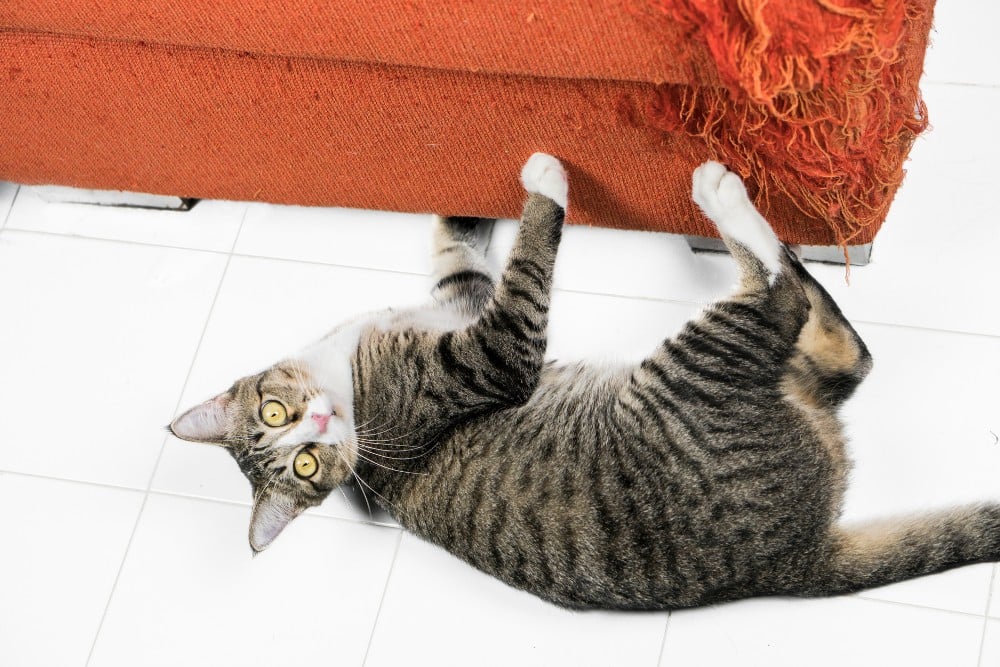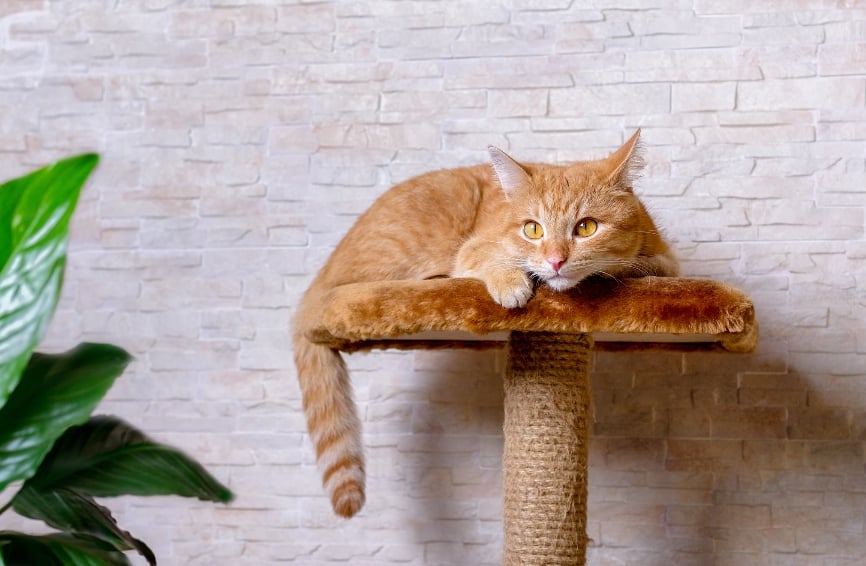Table of Contents
Whether your cat likes to do his scratching on a horizontal surface, a vertical surface, or both, he can do damage to furniture, carpet, and other items in your house. While you can’t really keep your cat from scratching, we’ve got some suggestions on what to do to protect your furniture (and redirect your cat’s claws!).
Why is my cat scratching?
Scratching is a natural activity for your cat – he doesn’t do it to be “naughty” or to get back at you for not letting him sleep on your head. He scratches to remove the dead outer layer of his claws and to mark his territory with his scent. He also scratches as part of play or for a good stretch. Notice when your cat scratches he’s not just working his nails, he’s stretching his entire body. He may want a nice scratch after a nap, or when he’s feeling particularly frisky. When you come home from a long day at work, he may scratch as part of his welcome home ritual.
How can I prevent my cat from scratching the furniture?
Give them an alternate scratching outlet
You can take several steps to prevent your cat from scratching in the wrong places by providing a scratching post, which can be made of wood, sisal, carpet or cardboard.
- Locate the places kitty normally likes to do his scratching and place scratching posts right in front of those off-limits spots (the corner of your couch is a good example). You can gradually move the scratching posts after your cat has gotten into the habit of using them.
- Cats like a sturdy post, so make sure his scratching posts are stable. Sprinkle a bit of catnip on and around the scratching posts to make them more attractive.
- Be sure to place scratching posts near his favorite sleep spots, and maybe near his litter box. And place them on all levels of your home—you want to be sure he has one whenever he gets the urge to work his nails.
- In addition to a post, a sisal clothes hamper with a lid can serve as a fun place for your cat to work his claws, plus you get the extra storage. He will love the textured surface and he can even enjoy a nice nap on top of it.
Give them plenty of enrichment
Be sure your cat is getting enough mental stimulation by offering them toys and an enriched environment. Make sure you’re offering the best type of cat toys for your pet’s personality. You can also DIY new cat toys for little to no cost.
Prevent access to scratching
You can also discourage your cat from scratching in the wrong places by covering them, blocking access, or making it less enjoyable for your cat. Here are some things to try:
- Cover forbidden spots with double-sided sticky tape or aluminum foil (both get the paws down from cats—they don’t like the texture).
- Cover furniture with plastic sheets.
- Apply citrus-based sprays to furniture. Most cats dislike the smell of citrus.
- Lay down a plastic floor runner with the nubby side up instead of down.
- Close doors to keep your cat out of certain rooms.
- Another technique is to set up motion-detection air spray cans near the furniture. These cans emit a hissing noise when the cat comes near.
- If you catch kitty in the act of scratching in the wrong place, clap your hands loudly to distract him, then redirect him to the acceptable scratching spot. Do this as a last resort because you don’t want your cat to fear you or associate their natural behavior as “wrong.”
Call a professional
If you’ve tried everything and your cat is relentless, it may be beneficial to work with a cat behavior specialist to finally beat the bad habits once and for all. A Certified Applied Animal Behaviorist (CAAB) or a board-certified veterinary behaviorist can help reduce excessive scratching behaviors with behavioral modification techniques, and in some cases, medications and supplements.
Remember: As part of responsible cat ownership, it’s a good idea to clip your cat’s claws regularly. If they get too long, they can grow into the delicate pads of the foot, causing pain and infection. If kitty won’t let you near his claws with the clippers, your vet tech can take care of it for you.








